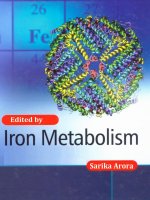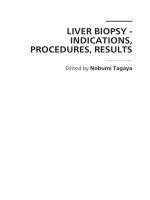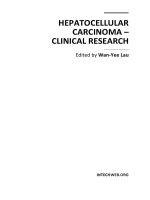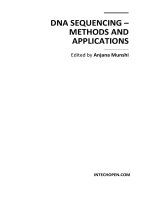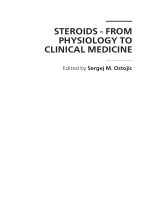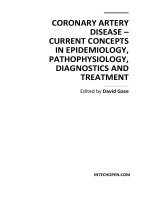Hepatocellular Carcinoma – Clinical Research Edited by Wan-Yee Lau pptx
Bạn đang xem bản rút gọn của tài liệu. Xem và tải ngay bản đầy đủ của tài liệu tại đây (29.99 MB, 340 trang )
HEPATOCELLULAR
CARCINOMA –
CLINICAL RESEARCH
Edited by Wan-Yee Lau
Hepatocellular Carcinoma – Clinical Research
Edited by Wan-Yee Lau
Published by InTech
Janeza Trdine 9, 51000 Rijeka, Croatia
Copyright © 2012 InTech
All chapters are Open Access distributed under the Creative Commons Attribution 3.0
license, which allows users to download, copy and build upon published articles even for
commercial purposes, as long as the author and publisher are properly credited, which
ensures maximum dissemination and a wider impact of our publications. After this work
has been published by InTech, authors have the right to republish it, in whole or part, in
any publication of which they are the author, and to make other personal use of the
work. Any republication, referencing or personal use of the work must explicitly identify
the original source.
As for readers, this license allows users to download, copy and build upon published
chapters even for commercial purposes, as long as the author and publisher are properly
credited, which ensures maximum dissemination and a wider impact of our publications.
Notice
Statements and opinions expressed in the chapters are these of the individual contributors
and not necessarily those of the editors or publisher. No responsibility is accepted for the
accuracy of information contained in the published chapters. The publisher assumes no
responsibility for any damage or injury to persons or property arising out of the use of any
materials, instructions, methods or ideas contained in the book.
Publishing Process Manager Vedran Greblo
Technical Editor Teodora Smiljanic
Cover Designer InTech Design Team
First published February, 2012
Printed in Croatia
A free online edition of this book is available at www.intechopen.com
Additional hard copies can be obtained from
Hepatocellular Carcinoma – Clinical Research, Edited by Wan-Yee Lau
p. cm.
ISBN 978-953-51-0112-3
Contents
Preface IX
Part 1 Diagnosis / Differential Diagnosis 1
Chapter 1 Hepatocellular Carcinoma: Epidemiology and Etiology 3
Davide Degli Esposti, Morando Soffritti, Antoinette Lemoine,
Eva Tibaldi and Marco Manservigi
Chapter 2 The Relationship Between Nonalcoholic Fatty Liver
Disease and Hepatocellular Carcinoma 39
Misael Uribe, Jesús Román-Sandoval,
Norberto C. Chávez-Tapia and Nahum Méndez-Sánchez
Chapter 3 Recent Advances in the Immunohistochemistry-Aided
Differential Diagnosis of Benign Versus Malignant
Hepatocellular Lesions 49
Péter Tátrai, Ilona Kovalszky and András Kiss
Chapter 4 The Histomorphological and Immunohistochemical
Diagnosis of Hepatocellular Carcinoma 65
Daniela Fanni, Clara Gerosa and Gavino Faa
Chapter 5 Signal Intensity Characteristics of Liver Masses at
Hepatobiliary Phase Images of Gadoxetate-Enhanced
MR (EOB-MR): Qualitative Assessment 89
Keiko Sakamoto, Yoshinobu Shinagawa, Ritsuko Fujimitsu,
Mikiko Ida, Hideyuki Higashihara,
Kouichi Takano and Kengo Yoshimitsu
Chapter 6 Differential Diagnosis of Hepatocellular Carcinoma on
Computed Tomography 105
Kristina Zviniene
Chapter 7 Strategic Assay Developments for Detection of HBV
1762T/1764A Double Mutation in Urine of Patients with
HBV-Associated Hepatocellular Carcinomas 139
Selena Y. Lin, Surbhi Jain, Wei Song, Chi-Tan Hu and Ying-Hsiu Su
VI Contents
Chapter 8 Usual and Unusual Gross Appearance of
Hepatocellular Carcinomas 155
Keita Kai, Atsushi Miyoshi, Kenji Kitahara,
Kohji Miyazaki, Hirokazu Noshiro
and Osamu Tokunaga
Part 2 Surgical Treatment 181
Chapter 9 Pure Laparoscopic Hepatectomy for HCC Patients 183
Zenichi Morise
Chapter 10 Major Hepatectomy without Allogeneic Blood Transfusion
for Hepatocellular Carcinoma 197
Jing An Rui
Part 3 Non-Surgical Treatment 209
Chapter 11 Medical Management Options for
Hepatocellular Carcinoma 211
Mehmet Sitki Copur and Angela Mae Obermiller
Chapter 12 The Most Important Local and Regional Treatment
Techniques of Hepatocellular Carcinoma and Their
Effect over a Long Term Overall Survival 225
Federico Cattin, Alessandro Uzzau and Dino De Anna
Chapter 13 Radiofrequency Ablation for Hepatocellular Carcinoma at
the Dome of the Liver: A Review 237
Kiyoshi Mochizuki
Chapter 14 Transcatheter Arterial Chemo-Embolization with
a Fine-Powder Formulation of Cisplatin for
Unresectable Hepatocellular Carcinoma 249
Kazuhiro Kasai and Kazuyuki Suzuki
Chapter 15 Transarterial Chemoembolization for
HCC with Drug-Eluting Microspheres 265
Maurizio Grosso, Fulvio Pedrazzini, Alberto Balderi,
Alberto Antonietti, Enrico Peano,
Luigi Ferro and Davide Sortino
Chapter 16 Therapy of Hepatocellular Carcinoma with
Iodine-131-Lipidiol 275
Hojjat Ahmadzadehfar, Amir Sabet,
Hans Jürgen Biersack and Jörn Risse
Chapter 17 Future Trends in the Management of
Advanced Hepatocellular Carcinoma (HCC) 289
Dimitrios Dimitroulopoulos and Aikaterini Fotopoulou
Contents VII
Chapter 18 Systemic Management of Advanced Hepatocellular
Carcinoma Patients: The Role of Multi-Targeted
Anti-Angiogenic Inhibitors 309
Joanne Chiu, Roberta Pang, Ronnie Poon and Thomas Yau
Chapter 19 Molecular Targeted Therapy for Growth Factors in
Hepatocellular Carcinoma 321
Junji Furuse
Preface
Hepatocellular Carcinoma – Clinical Research covers the clinical aspects of
hepatocellular carcinoma. Again this book is a compendium of papers written by
experts from different parts of the world to present the most-up-to-date knowledge on
the clinical aspects of hepatocellular carcinoma.
Hepatocellular Carcinoma – Clinical Research is divided into three sections: (I)
Diagnosis / Differential Diagnosis; (II) Surgical Treatment; and (III) Non-surgical
Treatment. There are altogether 19 chapters covering topics from novel diagnostic
methods to hepatic lesions mimicking hepatocellular carcinoma, from laparoscopic
liver resection to major hepatectomy without allogeneic blood transfusion, from
molecular targeted therapy to transarterial radioembolization, and from local ablative
therapy to regional therapy. This volume is an important contribution to the clinical
management of patients with hepatocellular carcinoma.
The intended readers of this book are clinicians who are interested in hepatocellular
carcinoma, including hepatologists, liver surgeons, interventional and diagnostic
radiologists, pathologists and epidemiologists. General surgeons, general physicians,
trainees, hospital administrators, and instrument and drug manufacturers will also
find this book useful as a reference.
Dr. Wan-Yee Lau
Department of Surgery, The Chinese University of Hong Kong,
Prince of Wales Hospital, Hong Kong SAR,
China
Part 1
Diagnosis / Differential Diagnosis
1
Hepatocellular Carcinoma:
Epidemiology and Etiology
Davide Degli Esposti
1,2
, Morando Soffritti
3,*
, Antoinette Lemoine
1,2
,
Eva Tibaldi
3
and Marco Manservigi
3
1
AP-HP, Hôpital Paul Brousse, Service de Biochimie et Biologie
Moléculaire, Inserm; Université Paris-Sud 11;
PRES Universud-Paris; Paul Vaillant Couturier
2
Laboratoire de Biochimie et Biologie Cellulaire, Faculté de Pharmacie,
Université Paris-Sud 11, Jean Baptiste Clément
3
Cesare Maltoni Cancer Research Center, Ramazzini Institute,
Castello di Bentivoglio, Via Saliceto, Bentivoglio, Bologna,
1,2
France
3
Italy
1. Introduction
Hepatocellular carcinoma (HCC) is a major public health problem, accounting for about
600,000 deaths in the world in 2004 (WHO, 2008). HCC is the sixth most common cancer
worldwide with about 500,000 new cases annually, representing the third largest cause of
cancer-related death (Parkin, 2005; Ferlay et al., 2010). A slight decrease in the HCC
incidence has been reported in high-rate areas, such as China and Japan (McGlynn et al.,
2001). However, a steadily increasing trend has been reported in historically low-rate
countries, particularly the United States and some European countries, such as Italy,
France, UK and Germany (IARC, 2008a; El-Seragh et al., 2007). In particular, HCC
incidence rates doubled in the United States in the period 1985-2002, an earlier age of
onset has been observed (with a shift towards 45-60 years old), and HCC has become the
fastest growing cause of cancer-related death in men (El-Seragh et al., 2004). Interestingly,
it has been reported that in the United States 15-50% of HCC patients had no established
risk factors, such as viral hepatitis infections, heavy alcohol consumption or aflatoxin B1
exposure (El-Seragh et al., 2007). Moreover, approximately 10% of all HCC cases in the
USA occur in patients with non-cirrhotic livers (Shaw & Shah, 2011). In Europe an
analysis of mortality rates from HCC trends in the last 20 years has shown increasing
rates for men in 11 countries and for women in 6 countries out of 17 whose data were
considered (Bosetti et al., 2008).
The observed increase in the incidence rates of HCC has been concomitant with the obesity
epidemic observed in the last 30 years in western countries. Obesity is one of the clinical
*
Corresponding Author
Hepatocellular Carcinoma – Clinical Research
4
manifestations of metabolic syndrome and, in the last decade, epidemiological and
experimental studies have shown that metabolic syndrome and high fat diets are associated
with an increased risk of HCC incidence/mortality (Bugianesi 2007; Starley et al., 2010;
Welzel et al., 2011). However, other causes may be involved in the increased incidence of
HCC and chemical-induced liver carcinogenesis appears to be a less considered etiology. In
this chapter, we will review recent acquisitions in epidemiology and experimental studies
on HCC and will focus on chemical risk factors and possible new mechanisms of liver
carcinogenesis, in particular those concerning metabolic disruption.
2. Chemical risk agents of hepatocellular carcinoma
Most human HCC occurs following viral hepatitis (mainly HBV or HCV) infections or
aflatoxin B1 exposure caused by ingestion of contaminated food (IARC 2008a). However,
the epidemiological evidence shows that the human liver is susceptible to chemical-
induced carcinogenesis (Blonski et al., 2010; Degli Esposti et al., 2009) and the increased
incidence of HCC in patients not having established risk factors (El-Seragh et al., 2007)
suggests that some underestimated or new but still not recognized risk factors exist
(Blonski et al., 2010). In particular, many natural and artificial agents have been shown by
experimental or epidemiological studies to induce HCC (Table 1). In this section we will
review the chemical risk factors of HCC as emerging from the epidemiological and
experimental data.
2.1 Human hepatocarcinogens
Various classes of chemicals are reported to induce HCC in humans: drugs or hormonal
therapies (azathioprine, tamoxifen and estrogen-progesteron oral contraceptives) (IARC,
2011); radioisotopes or heavy metals (Plutonium-239, Radium-224, Thorium-232; arsenic in
drinking water) (IARC, 2001; IARC, 2004b); complex mixtures of polyaromatic
hydrocarbons (PAH) and combustion products (soots and tobacco smoking)(IARC, 1987;
IARC, 2004a); organochlorines such as vinyl chloride monomer (VCM) or 2,3,7,8
tetrachloride-dibenzo-para-dioxin (TCDD) (IARC, 2008b, IARC, 1997); and plant derivatives
(betel or Areca catechu) (IARC, 2004c). Recently, some psychoactive substances, like
cannabinoids, have been reported to worsen liver steatosis and fibrosis, in particular in the
presence of HCV infections (Hézode et al., 2008, Parfieniuk & Flisiak, 2008). However, no
evidence of carcinogenicity has been shown for delta 9-tetrahydrocannabinol (the principal
psychoactive ingredient in marihuana) in rats and mice (Chan et al., 1996). More research is
warranted to assess the long-term carcinogenic or co-carcinogenic effects of cannabinoids,
particularly in the liver, as assumption of them during cannabis smoking may result in
cannabinoid exposure for a large population. Finally, recent reviews have focused on a
possible underestimation of non-viral causes of HCC (Blonski et al., 2010; Degli Esposti et
al., 2009). In particular, metabolic disorders (Non-Alcoholic Fatty Liver Disease (NAFLD),
obesity and diabetes), hormonal drugs (oral contraception, tamoxifen), organochlorine
compounds, polycyclic aromatic hydrocarbons, tobacco smoking, betel quid chewing and
dietary exposures (in particular arsenic in drinking water and aflatoxin B1, a well known
hepatocarcinogen) are indicated as important contributing factors for HCC (Blonski et al.,
2010; Degli Esposti et al., 2009).
Hepatocellular Carcinoma: Epidemiology and Etiology
5
Agents Human exposure Evidence of
carcinogenicity
References
Cate
g
or
y
T
y
pe Humans Experimental
animals
Natural 1. Aflatoxins food contaminant + +
(rice, peanuts, etc.)
Wo
g
an and
Newbern 1967;
Wo
g
an et al.
1974; Yeh et al.
1985;
Olsen et al.
1988; IARC
1993;
Soffritti et al.
1988
2. Alcohol lifest
y
le dependent +
Hakulinen et
al. 1974;
Adelstein and
White 1976;
Hira
y
ama
1981; IARC
1988
3. Hepatitis B virus blood transfusion + + Sn
y
der et al.
1982; Buendia
1992
4. Steri
g
matoc
y
stin food contaminant
(grain, legumes)
+ Purchase and
van der Watt
1970
5. Luteoschirina food contaminant rice
+Ura
g
uchi et al.
1972
6. C
y
cloclorotina food contaminant rice + IARC 1976
7. P
y
razolidinic
Alkaloids
plants contaminant
+ Swoboda and
Reddy 1972
8. C
y
casin alimentar
y
exposure + Laquer et al.
1963
9. Safrole flavourin
g
substance
+Lon
g
et al.
1963; Hagan et
al. 1965
+ = strong evidence; (+) = limited evidence
Table 1. Agents inducing Hepatocellular Carcinoma based on experimental/epidemiological
evidence (Part I)
Hepatocellular Carcinoma – Clinical Research
6
A
g
ents Human exposure Evidence of
carcinogenicity
References
Cate
g
or
y
T
y
pe Humans Experimental
animals
Artificial 1. Thorotrast iatro
g
enic (+) + Guimares et al.
1955;
Commission of
European
Communities
(CEC) 1984
2. Radioactive iatro
g
enic + Upton et al. 1956
colloidal
g
old
3. Gamma radiation occupational or + Upton et al. 1968
accidental
4. Vinyl Chloride occupational (+) +
Gokel et al. 1976;
Koischwitz et al.
1981;
Evans et al. 1983;
Maltoni et al.
1984;
Dietz et al. 1985,
Pirastu et al. 1990
5. Benzidine occupational + IARC 1982
6. 2-Acet
y
lamino-
fluorene
occupational
+ Wilson et al. 1941;
Teebor and
Becker 1971
7. 4-Dieth
y
lamino-
azobenzene
occupational
+ Kinosita 1936
Terayama 1967
8. Dimeth
y
l-
nitrosamina
occupational
+Ma
g
ee and
Barnes 1956
9. Dieth
y
lnitrosamina occupational + Schmal et al. 1960
10. Steroidal oral
contraceptives
iatro
g
enic (+) (+) Klatskin 1977; Jick
and Hermann
1978;
IARC 1979
11. Andro
g
en steroids iatro
g
enic (+)
Johnson et al.
1972
+ = strong evidence; (+) = limited evidence
Table 1. Agents inducing Hepatocellular Carcinoma based on experimental/epidemiological
evidence (Part II)
The diversity of chemical agents that induce liver tumors in humans may be at least
partially explained by the multiplicity of molecular pathways that have been found altered
both in human and animal hepatic tumors (Degli Esposti et al., 2009; Saffroy et al., 2007).
Hepatocellular Carcinoma: Epidemiology and Etiology
7
Hormonal-induced liver tumors, such those observed after estrogen-progesteron oral
contraceptives and tamoxifen administration, have been in part explained by promotion of
the epithelium proliferation and the generation of reactive oxygen species (ROS) caused by
estrogen reactive metabolites (Russo & Russo, 2006) and ER-dependent liver responses, such
as hepatocyte mitogenesis (Vickers et al., 1991). Liver carcinogenicity of alpha-particle
emitters, in particular Plutonium-239, Radium-224, Thorium-232, and heavy metals such as
arsenic may be explained by their ability to induce direct or indirect genotoxic damage
(Lehnert et al., 1997; IARC, 2004b). The carcinogenicity of VCM has been linked to the
capacity of its two active metabolites (chloroethylene oxide and chloroacetaldehyde) to react
with nucleic acid bases to form adducts (IARC, 2008b) and to induce p53 mutations both in
humans and in rats (Barbin et al., 1997). It is worth noting that 10-40% of HCC are
characterized by global genomic instability as shown by microsatellite analyses and that the
exact mechanisms behind this instability still need to be assessed (Salvucci et al., 1999,
Chiappini et al., 2004).
Gene polymorphisms and gene-environment interactions may also be risk factors for HCC,
particularly concerning gene coding for metabolizing enzymes (glutathione-S-transferase,
epoxide hydrolase, cytochrome p4502E1) or DNA repairing enzymes (XRCC1, UDP-
glucuronosyltransferase1A7)(Wong et al., 2000, Borentain, 2007). However, until now, these
studies have reported contrasting results. Meta-analysis and additional studies with larger
samples should be performed in order clarify the role of genetic polymorphisms in the onset
of HCC (El-Seragh, 2007; White et al., 2008).
Overall, these data clearly indicate that the human liver is sensitive to chemical-induced
carcinogenesis and that xenobiotic exposure could play an underestimated role in inducing
hepatocellular carcinomas, alone or associated with already known etiologies.
2.2 Long-term carcinogenicity bioassays as a tool to identify potential
hepatocarcinogens
Long-term carcinogenicity bioassays, mainly using rats and mice, have become a
consolidated tool for identifying potentially carcinogenic chemical or physical agents (Huff,
2002; Maronpot et al., 2004; Soffritti et al., 2002). The two most extensive bioassay programs
in the world are those of the American National Toxicology Program (NTP) and of the
Italian Ramazzini Institute (Bucher, 2002; Huff, 2002; Soffritti et al., 2002). Although
differences in the etiology exist between rodent and human HCC, there are also significant
similarities in the genetic alterations leading to liver cancer in mice, rats and humans
(Hoenerhoff et al., 2011; Feo et al., 2009). A recent study performed a global gene profiling of
spontaneous (naturally occurring) HCC in B6C3F1 mice used in the NTP two-year bioassay
(Hoenerhoff et al., 2011). The authors identified the dysregulation of genes similarly altered
in human HCC, namely re-expression of fetal oncogenes, upregulation of protooncogenes,
downregulation of tumor suppressor genes, and abnormal expression of cell cycle
mediators, growth factors, apoptosis regulators, angiogenesis and extracellular matrix
remodeling factors (Hoenerhoff et al., 2011). The use of a pathway-centered approach has
lead to the identification of important targets that may be relevant to human HCC and,
despite differences in etiology and pathogenesis from human HCC, the molecular readout
has proved very similar, thus providing further support for applying this animal model to
the study of HCC (Hoenerhoff et al., 2011). Importantly, the results from the two-year
Hepatocellular Carcinoma – Clinical Research
8
carcinogenicity bioassays conducted by the NTP show that 188 out of 577 tested agents
induced liver tumors in Fischer 344 rats or B6C3F1 mice (Table 2). Interestingly, 76% of these
agents (145 out of 188) induced cancer in other sites than the liver (NTP, 2011). In particular,
concerning the use of B6C3F1 mice, it has been suggested that this model might be a very
sensitive system to detect chemicals that are likely to cause molecular events leading to
cancer (Hoenerhoff et al., 2011). Results from the long term carcinogenicity bioassay
program performed by the Cesare Maltoni Cancer Research Center of the Ramazzini Institute
reveal that, among the studies already concluded and published, 52 agents showed clear
evidence of carcinogenicity and 5 of them induced liver tumors in Sprague-Dawley rats or
Swiss mice (Table 3). Interestingly, all these agents also induced cancer in other sites than
the liver. These results confirm the finding that different strains of rats and mice present a
different susceptibility to the development of HCC (Feo et al., 2009; Maronpot 2009). It
should be noted that recent studies on genetic susceptibility and epigenetic regulation of the
signaling pathways involved in hepatocarcinogenesis in rats have shown that most
alterations responsible for a resistant or susceptible phenotype in rats also have a similar
contribution to the prognosis of human HCC (Feo et al., 2009). In conclusion, the results of
both long-term carcinogenicity studies and of genetic investigation of HCC from rodent
models may provide important insights into the mechanisms of hepatocarcinogenesis,
helping to identify some critical initiating events that lead to carcinogenesis, as well as
progression markers and therapeutic targets (Feo et al., 2009; Hoenerhoff et al., 2011).
Agents Route of
exposure
Evidence of
carcinogenicity
b
Carcino-
genicity in
other site
Human exposure
N. T
y
pe Rats Mice
MFMF
1 Acetonitrile Inhalatio
n
E NE NE NE No chemical industr
y
2 Aldrin Dosed-feed E E CE NE Yes pesticide
3
2-Aminoanthra-
quinone Dosed-feed CE IS CE CE Yes d
y
e industr
y
4 1-Amino- Dosed-feed CE CE CE CE Yes d
y
e industr
y
2,4-dibromoanthra-
quinone
5 3-Amino- Dosed-feed CE CE CE CE Yes d
y
e industr
y
9-eth
y
lcarbazole HCl
6
11-Aminoundecanoic
acid Dosed-feed CE NE E NE Yes car industry;
food packa
g
in
g
7 Androstenedione Gava
g
e E E CE CE Yes hormonal treatment
8 Anthraquinone Dosed-feed SE CE CE CE Yes d
y
e industr
y
9 Aroclor 1254 Dosed-feed E E Yes insulator for current
transformers
10 Benzofura
n
Gava
g
eNESECECE Yes paintin
g
industr
y
;
food packa
g
in
g
Hepatocellular Carcinoma: Epidemiology and Etiology
9
Agents Route of
exposure
Evidence of
carcinogenicity
b
Carcino-
genicity in
other site
Human exposure
N. T
y
pe Rats Mice
11 Benzophenone Dosed-feed SE E SE SE Yes printin
g
industr
y
12 Benz
y
l acetate Gava
g
e E NE SE SE Yes cosmetic industr
y
13
2-Chloro-1-
methylethyl Gavage CE CE Yes dye industry;
ether pharmaceutics
14
Bromodi-
chloromethane Gavage CE CE CE CE Yes water contaminant
15 1,3 Butadiene Inhalation CE CE Yes chemical industry:
plastic and rubber
16 2-Butoxyethanol Inhalation NE E SE SE Yes painting industry
17 Chloral hydrate Gavage SE No drugs treatment
18 Chloramben Dosed-feed NE NE E CE No herbicide
19 Chlordane Dosed-feed NE NE CE CE No pesticide
20 Chlordecone Dosed-feed CE CE CE CE No insecticide, fungicide
21 Chlorendic acid Dosed-feed CE CE CE NE Yes plastic industry
22
Chlorinated paraffins:
C12 Gavage CE CE CE CE Yes combustion products;
60% chlorine oils
23
Chlorinated paraffins:
C23 Gavage NE E CE E Yes combustion products;
43% chlorine oils
24 p-Chloroaniline Gavage CE E SE NE Yes dye industry
hydrochloride
25
Chlorobenzene Gavage E NE NE NE No chemical industry;
solvents
26
Chlorobenzilate Dosed-feed E E CE CE Yes insecticide
27
Chlorodi-
bromomethane Gavage NE NE E SE No water contaminant
28
Chloroethane Inhalation E E IS CE Yes chemical industry;
anaesthetic
29
Chloroform Gavage CE NE CE CE Yes chemical industry;
anaesthetic
30
4-Chloro-m Dosed-feed CE NE NE CE Yes dye industry
phenylenediamide
Hepatocellular Carcinoma – Clinical Research
10
Agents Route of
exposure
Evidence of
carcinogenicity
b
Carcino-
genicity in
other site
Human exposure
N. T
y
pe Rats Mice
31 4-Chloro-o Dosed-feed CE CE CE CE Yes dye industry
phenylenediamide
32 Chloroprene Inhalation CE CE CE CE Yes chemical industry
33 5-Chloro-o-toluidine Dosed-feed NE NE CE CE Yes dye industry
34 C.I. Acid red 114
Dosed-
water CE CE
Yes
dye industry
35 C.I. Direct blue 15
Dosed-
water CE CE
Yes
dye industry
36 C.I. Direct blue 218 Dosed-feed SE NE CE CE Yes dye industry
37 C.I. Disperse blue 1 Dosed-feed CE CE E NE Yes hair colouring
38 C.I. Disperse yellow 3 Dosed-feed CE NE NE CE Yes dye for clothes
39 C.I. Pigment red 3 Dosed-feed SE SE SE NE Yes dye industry
40 C.I. Basic red 9 Dosed-feed CE CE CE CE Yes dye industry;
monohydrochloride clothes, paper,leather
41
Cinnamyl
anthranilate Dosed-feed CE NE CE CE Yes synthetic flavour
42 C.I. solvent yellow 14 Dosed-feed CE CE NE NE Yes dye industry
43 Coconut oil acid
Topical
application NE E CE CE Yes cosmetic industry
diethanolamine
44 Coumarin Gavage SE E SE CE Yes pharmaceutical use
45 p-Cresidine Dosed-feed CE CE CE CE Yes dye industry
46 Cumene Inhalation CE SE CE CE Yes chemical industry
47 Cupferron Dosed-feed CE CE CE CE Yes chemical industry
48 Daminozide Dosed-feed NE CE E NE Yes plants growing
regulator
49 D & C red 9 Dosed-feed CE E NE NE Yes cosmetic industry
50 D & C yellow 11 Dosed-feed SE SE Yes cosmetic industry
51 Decabromodiphenyl Dosed-feed Se SE E NE Yes plastic industry
oxide
52 Decalin Inhalation CE NE NE E Yes industrial solvent
Hepatocellular Carcinoma: Epidemiology and Etiology
11
Agents Route of
exposure
Evidence of
carcinogenicity
b
Carcino-
genicity in
other site
Human exposure
N. T
y
pe Rats Mice
53 2,4 Diaminotoluene Dosed-feed CE CE NE CE Yes d
y
e industr
y
54 1,2 Dibromoethane Gava
g
eCECE CE CEYes
g
asoline additive;
pesticide
55 2,3 Dibromo-1-
propanol
Topical
application
CE CE CE CE Yes pesticide
56 1,4 Dichlorobenzene Gava
g
e CE NE CE CE Yes moth killer; deodorant
57 2,7 Dichlorodibenzo
dioxin-
Dosed-feed NE NE E NE Yes pesticides
contaminant
58 p,p'-Dichlorodiphen
y
l Dosed-feed NE NE CE CE No insecticide
dichloroeth
y
lene
59 2,6- Dichloro-p- Dosed-feed NE NE CE CE No chemical industr
y
phen
y
lenediamine
60 1,2- Dichloropropane Gava
g
e NE E SE SE Yes chemical industr
y
61 1,3-Dichloropropene Gava
g
e CE SE IS CE Yes pesticide
62 Dicofol Dosed-feed NE NE CE NE No mitecide
63 Dieldrin Dosed-feed NE NE E NE No insecticide
64 Diethanolamine Topical
applicatio
n
NE NE CE CE Yes chemical industr
y
65 Di(2-eth
y
lhex
y
l) Dosed-feed NE NE CE CE No poliv
y
nil plastic
adipate
66 Di(2-eth
y
lhexi
y
l) Dosed-feed CE CE CE CE No poliv
y
nil plastic
phthalate
67 Di(p-eth
y
lphen
y
l) Dosed-feed NE NE NE E No insecticide
dichloroethane
68 Diethyl phthalate
Topical
application NE NE E E No plastic industry
69 3,4-Dih
y
drocoumarin Gava
g
e SE NE NE SE Yes pharmaceutical use
70
3,3'-
Dimetoxybenzidine
Dosed-
water CE CE Yes dye industry
dih
y
drochloride
71 1,4 Dioxane
Dosed-
water CE CE CE CE Yes d
y
e, cosmetic
and plastic
industry
Hepatocellular Carcinoma – Clinical Research
12
Agents Route of
exposure
Evidence of
carcinogenicity
b
Carcino-
genicity in
other site
Human exposure
N. T
y
pe Rats Mice
72 5,5-
Diphenylhidantoin
Dosed-feed E NE NE CE No pharmaceutical use
73 2,5-Dithiobiurea Dosed-feed NE NE NE E No film material
74 Elmiron Gavage NE NE SE SE Yes pharmaceutical use
75 Ethylbenzene Inhalation CE SE SE SE Yes chemical industry
76 Ethylene thiourea Dosed-feed CE CE CE CE Yes rubber industry
77 Eugenol Dosed-feed NE NE E E No flavouring
compound
78 Fluometuron Dosed-feed NE NE E NE No herbicide
79 Formamide Gavage NE NE CE E No pharmaceutical use
80 Fumonisin B1 Dosed-feed CE NE NE CE Yes toxin
81 Furan Gavage CE CE CE CE Yes polymers industry
82 Furfural Gava
g
e SE NE CE SE Yes food additive
83 Gl
y
cidol Gava
g
eCECE CE CEYesplastic industr
y
84 Goldenseal root Dosed-feed CE CE SE NE No homeopathic use
powder
85 HC blue 1 Dosed-feed E SE CE CE Yes hair colourin
g
86 HC red 3 Gava
g
e NE NE E IS No hair colourin
g
87 Heptachlor Dosed-feed NE E CE CE Yes insecticide
88 1,2,3,6,7,8-
Hexachloro
Gava
g
e E CE CE CE No pesticides
contaminant
dibenzo-p-dioxin
89 Hexachloroethane Gava
g
e NE NE CE CE No chemical industr
y
;
veterinar
y
use
90 H
y
drazobenzene Dosed-feed CE CE NE CE Yes d
y
e industr
y
91 H
y
drochlorothiazide Dosed-feed NE NE E NE No pharmaceutical use
92 H
y
droquinone Gava
g
e SE SE NE SE Yes rubber and film
industr
y
93 5-(H
y
drox
y
meth
y
l)-2 Gava
g
e NE NE NE SE No food additive
-furfural
Hepatocellular Carcinoma: Epidemiology and Etiology
13
Agents Route of
exposure
Evidence of
carcinogenicity
b
Carcino-
genicity in
other site
Human exposure
N. T
y
pe Rats Mice
94 Indium phosphide Inhalation CE CE CE CE Yes electronic industry
95 Isoeugenol Gavage E NE CE E Yes flavouring
compound
96 Isophorone Gavage SE NE E NE Yes solvent
97 Lauric acid
Topical
application NE NE NE SE No pharmaceutical use
diethanolamine
condensate
98 Leucomalachite green Dosed-feed E E SE Yes dye industry
99 Malachite green Dosed-feed E NE Yes dye industry
100 2-Mercaptobenzo Gavage SE SE NE E Yes rubber industry
thiazole
101 Methyl carbamate Gavage CE CE NE NE No texil industry
102 4,4'-Methylenebis Dosed-feed CE CE E CE Yes dye industry
(N,N-dimethyl)
benzenamine
103 Methylene chloride Inhalation SE CE CE CE Yes chemical industry
104
4,4' -
Methylenedianiline
Dosed-
water CE CE CE CE Yes chemical industry
dihydrochloride
105 Methyleugenol Gavage CE CE CE CE Yes flavouring
industry
106 2-Methylimidazole Dosed-feed SE CE SE SE Yes chemical industry
107 Methyl isobutyl Inhalation SE E SE SE Yes solvent
ketone
108 2-Methyl-1-nitro Dosed-feed CE CE CE CE Yes dye industry
anthraquinone
109 N-
Methylolacrylamide
Gavage NE NE CE CE Yes adhesive industry
110 Methylphenidate Dosed-feed NE NE SE SE No pharmaceutical use
hydrochloride
111 alpha-Methylstyrene Inhalation SE NE E CE Yes plastic industry
112 Michler's Ketone Dosed-feed CE CE CE CE Yes dye industry
Hepatocellular Carcinoma – Clinical Research
14
Agents Route of
exposure
Evidence of
carcinogenicity
b
Carcino-
genicity in
other site
Human exposure
N. T
y
pe Rats Mice
113 Mirex Dosed-feed CE CE Yes insecticide
114 Monuron Dosed-feed CE NE NE NE Yes herbicide
115 beta-M
y
rcene Gava
g
e CE E CE E Yes cosmetic industr
y
116 1,5-Naphthalene Dosed-feed NE CE CE CE Yes chemical industr
y
diamine
117 Nithiazide Dosed-feed NE CE CE E Yes veterinar
y
use
118 5-Nitroacenaphthene Dosed-feed CE CE NE CE Yes d
y
e industr
y
119 3-nitro-p-
acetophenetide
Dosed-feed NE NE CE NE No pharmaceutical use
120
5-nitro-o-aniside Dosed-feed CE CE E CE Yes dye industry
121
o-Nitroanisole Dosed-feed CE CE CE SE Yes chemical industr
y
122
6-Nitrobenzimidazole Dosed-feed NE NE CE CE No film industry
123
Nitrofen Dosed-feed IS/NE CE/NE CE CE
Yes/N
o pesticide
124 Nitromethane Inhalatio
n
NE CE CE CE Yes en
g
ine fuel
125 2-Nitro-p-phen
y
l Dosed-feed NE NE NE CE No hair colourin
g
enediamine
126 3 Nitropropionic acid Gava
g
e E NE NE NE Yes chemical industr
y
127 p-Nitrosodiphen
y
l-
amine
Dosed-feed CE NE CE NE No rubber industr
y
128 o-Nitrotoluene Dosed-feed CE CE CE CE Yes d
y
e industr
y
129 5-Nitro-o-toluidine Dosed-feed NE NE CE CE Yes d
y
e industr
y
130 Oxazepam Dosed-feed CE CE Yes pharmaceutical use
131 4,4' Ox
y
dianiline Dosed-feed CE CE CE CE Yes metallur
g
ic
industr
y
132 Ox
y
metholone Gava
g
e E CE Yes pharmaceutical use
133 Petachloroethane Gava
g
e E NE CE CE Yes chemical industr
y
134 Pentachlorophenol Dosed-feed CE CE Yes insecticide
Dowicide EC-7
135 Pentachlorophenol Dosed-feed CE SE Yes insecticide
technical
Hepatocellular Carcinoma: Epidemiology and Etiology
15
Agents Route of
exposure
Evidence of
carcinogenicity
b
Carcino-
genicity in
other site
Human exposure
N. T
y
pe Rats Mice
136 Phenazop
y
ridine Dosed-feed CE CE NE CE Yes pharmaceutical use
h
y
drochloride
137 Phen
y
lbutazone Gava
g
e E SE SE NE Yes pharmaceutical use
138
Picloram Dosed-feed NE E NE NE No herbicide
139
Piperonyl Dosed-feed NE NE CE NE No insecticide
sulfoxide
140 Polibrominated
biphenyl mixture
Dosed-feed
and
CE CE CE CE No engine fuel
(Firemaster FF-1) Gavage
141
Primidone Dosed-feed E NE CE CE Yes pharmaceutical use
142
Probenecid Gavage NE NE NE SE No pharmaceutical use
143 Proflavin
hydrochloride
Dosed-feed E NE E E Yes pharmaceutical use
144
Propylene glycol Inhalation E NE CE CE Yes solvent
mono-t-butyl ether
145
Pulegone Gavage NE SE CE CE Yes cosmetic use
146
Pyridine
Dosed-
water SE E CE CE Yes chemical industry
147
Riddelliine Gavage CE CE CE CE Yes food contaminant
148 Salicylazosulfa-
pyridine
Gavage SE SE CE CE Yes pharmaceutical use
149
Selenium sulfide Gavage CE CE NE CE Yes cosmetic use
150
Stoddard solvent Inhalation SE NE NE E Yes solvent
(type 1IC)
151 Binary mixture PCB
126/153
Gavage CE Yes chemical industry
(TEF evaluation)
152
PECDF Gavage SE Yes chemical industry
(TEF evaluation)
153
PCB 118 Gavage CE Yes chemical industry
(TEF evaluation)

